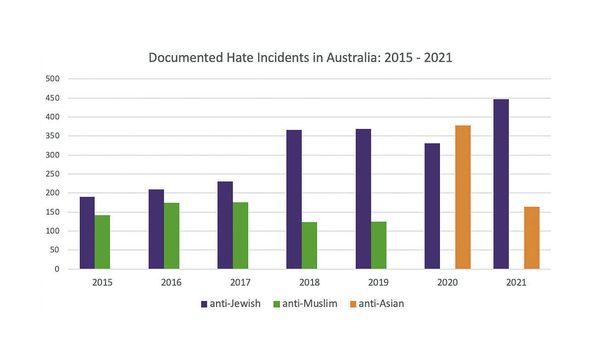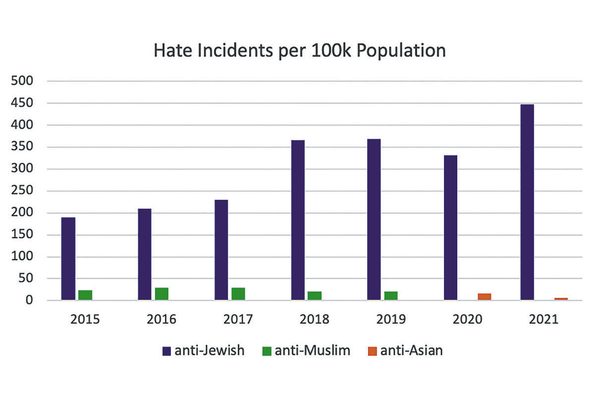Hate in Australia: the statistics
A comprehensive study has revealed a clearer picture of the state of reported hate incidents in Australia from 2014 to 2021.
The study was based on the reports of three targeted communities – Jewish, Muslim and Asian – the only communities who have a reporting and documentation system, and which produce reports on hate incidents against their community.
The study found that there were 3522 reported hate incidents in the seven-year period between September 17, 2014 and September 30, 2021. That amounts to an average of over one incident a day. There are two periods, corresponding to different reporting periods of the communities.
In the first period, in the five years between late 2014 and 2019, there were 2203 reported hate incidents. These were composed of 1364 anti-Jewish incidents (in the 60 months from October 1, 2014 to September 30, 2019) and 839 anti-Muslim incidents (in the 64 months from September 17, 2014 to December 31, 2019).
In the second period, in the two years of 2020 and 2021, there were 1319 reported hate incidents. These were composed of 778 anti-Jewish incidents (in the 24 months from October 1, 2019 to September 30, 2021) and 541 anti-Asian incidents (in the 15 months from April 2, 2020 to June 28, 2021).

The intensity of hate incidents on communities can be understood through proportionality. According to the Australian Bureau of Statistics, in 2016 in Australia there were just under 100,000 Jews, 604,000 Muslims, and 2.4 million people of East and South-East Asian ancestry. This means that proportionally, for every 100,000 people in each community, there were 306 anti-Jewish incidents, 24 anti-Muslim incidents, and 18 anti-East/South-East Asian incidents, on average annually.
The Executive Council of Australian Jewry (ECAJ) has produced an annual report on antisemitism each year since 1990, spurred on by a spate of arson attacks on synagogues in 1990 and 1991. There was a total of 2142 anti-Jewish incidents reported for the seven years from October 1, 2014 to September 30, 2021; averaging 306 incidents annually.
The annual number of anti-Jewish incidents ranged from 190 in 2015 to 447 in 2021. Anti-Jewish incidents, documented in the 2021 ECAJ report, as a percentage of the total number of incidents, comprised: verbal abuse 33 per cent; graffiti 24 per cent; email, postal, phone 23 per cent; placards, posters, stickers 16 per cent; physical assault two per cent; and vandalism two per cent.
The Islamophobia Register Australia (IRA) was established “in response to increasing harassment and attacks” against Muslims after police raids in Sydney and Brisbane in 2014. There was a total of 839 anti-Muslim incidents reported between September 17, 2014 and December 31, 2019, a 64-month period, of which 388 (47 per cent) were online posts/comments. The average number of anti-Muslim incidents annually for the five years between 2015 and 2019 was 147.
The three reports by IRA documented 243 incidents in 2014 and 2015 (16 months), 349 in 2016 and 2017 (24 months), and 247 in 2018 and 2019 (24 months). Of these incidents, 55 per cent, 42 per cent and 44 per cent, respectively, were online content.
IRA’s 2018-2019 report noted that the 138 offline incidents comprised: hate speech (46 per cent); discrimination (14 per cent); discrimination by authorities (14 per cent); graffiti/vandalism (13 per cent); physical assault (eight per cent); damage to individuals (three per cent); and property damage (two per cent). Of the 109 online incidents, these occurred on Facebook (86 per cent); email (six per cent); online media (six per cent); and Twitter (six per cent). These percentages were similar to those in the second report.

The Asian Australian Alliance (AAA) report was motivated by the racism against Asians in Australia arising from the COVID-19 pandemic. The first report covered the two-month period from April 2, 2020 to June 2, 2020 and recorded 377 incidents. The second report covered the 13-month period from June 3, 2020 to June 28, 2021, recording 164 incidents. This is a total of 541 anti-Asian incidents over a 15-month period, and an average of 432 incidents for a 12-month period.
In the second AAA report, incidents comprised: direct racial slur/name calling (35 per cent); online harassment (25 per cent); making it out as a joke (13 per cent); verbal threats (eight per cent); getting spat/sneezed/coughed on (seven per cent); physical intimidation/harassment (seven per cent); shunning (six per cent); workplace discrimination (two per cent); and other categories of discrimination under two per cent.
These 3522 hate incidents comprise only a proportion of hate incidents occurring. Many other anti-Jewish, anti-Muslim and anti-Asian incidents are unreported. In addition, incidents against other targeted communities go unreported due to the lack of an organisation which takes reports for these communities.
The hate incident data by these three targeted communities can be used by governments, human rights bodies, police, and others, to formulate policies and practices towards countering hate incidents. Hence, it is crucial that all those targeted by hate incidents report such incidents to the appropriate body, where there is one.
Julie Nathan is research director at the Executive Council of Australian Jewry.


comments